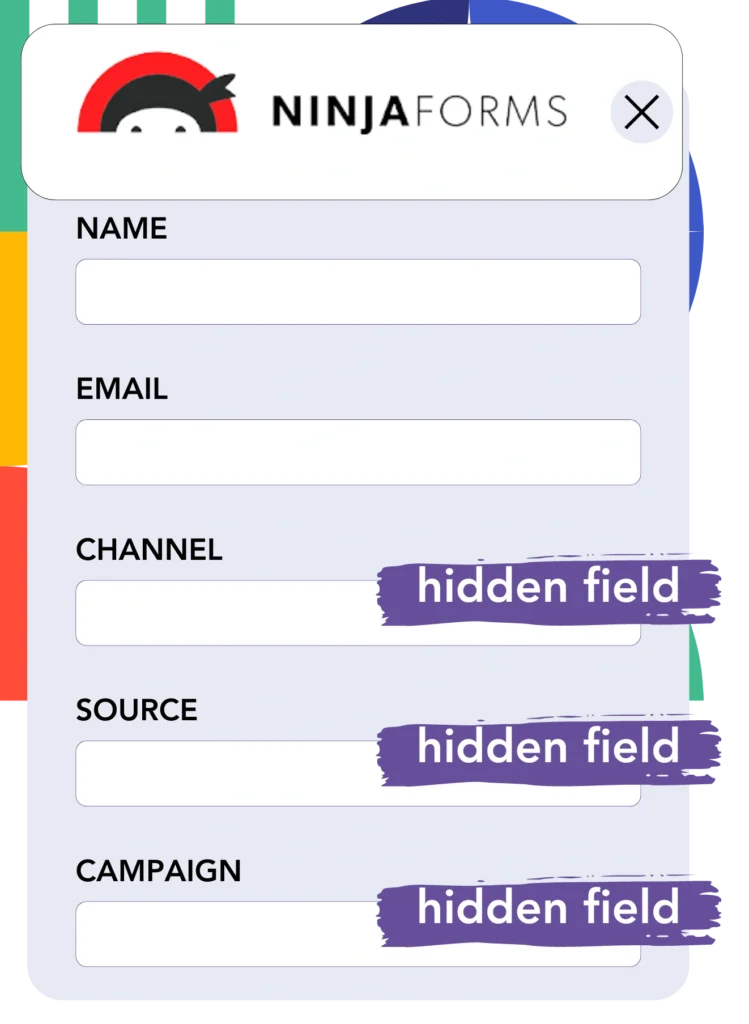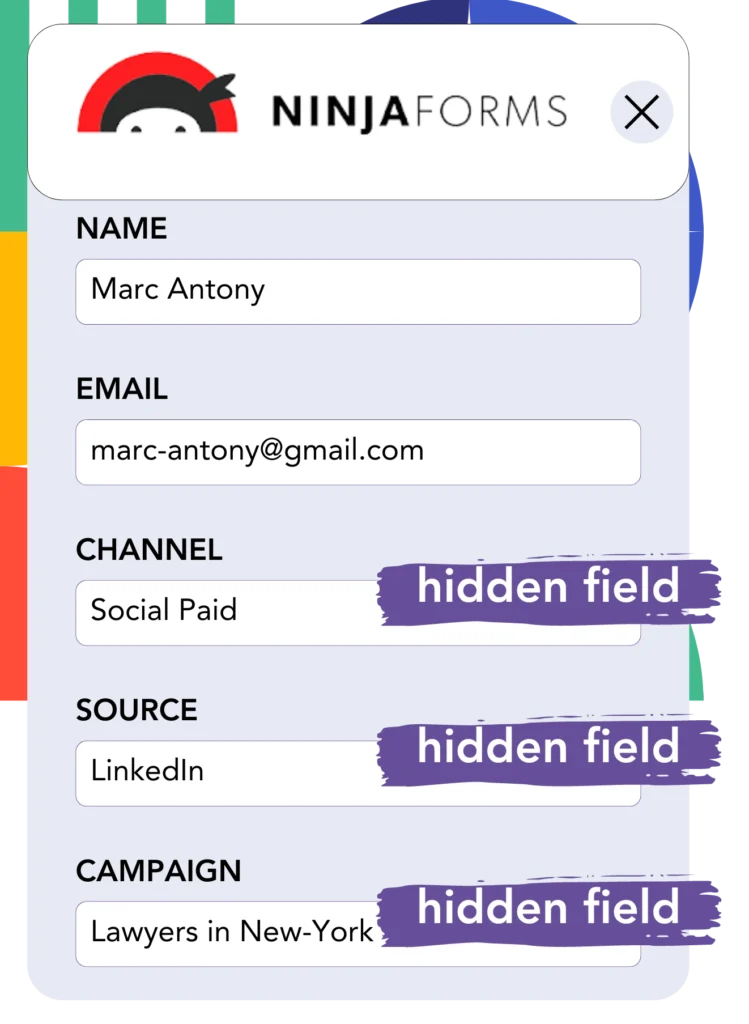Optimizing LinkedIn ads involves understanding which ad is driving your leads, sales, and revenue.
Although you know the total leads from each LinkedIn ad, the ability to break it down at a lead level is not available.
This uncertainty leaves you unable to identify which LinkedIn ad drove customer conversions, making it difficult to improve your budget.
With Leadsources, the problem is effectively managed.
Leadsources enables the capture of LinkedIn ads data, including campaign, audience, ad, etc., down to each lead.
Ninja Forms allows you to store detailed LinkedIn ad data, including campaign information, audience insights, and ad specifics, for each lead.
Running reports such as “Ads that generated the most leads” gives you insight into which ads should be promoted or discontinued.
Let’s dive into it!
Capture LinkedIn ads in Ninja Forms
Step 1: Add Leadsources in the head tag of your website

Sign up to Leadsources.io, and benefit from our 14-day free trial.
Set the Leadsources tracking code within the head tag of your site.
No code is necessary, follow this easy step-by-step guide.
Step 2: Add the UTM parameters to your LinkedIn campaigns

Integrate the UTM parameters you wish to track into all your LinkedIn ads, such as campaign, audience, ad, etc.
For example, reflect using these UTM parameters in the links of your LinkedIn ads:
- UTM_source
- UTM_campaign
- UTM_term
- UTM_content
Note that Leadsources can gather lead source data without UTM parameters, such as channel, landing page, and landing page subfolder, allowing for a complete assessment of your leads.
Step 3: Add the hidden fields in Ninja Forms

When individuals complete your Ninja Forms form, Leadsources ensures that the hidden fields are filled with LinkedIn ads data, such as campaign, audience, ad, etc.
Follow our in-depth instructions to add hidden fields in Ninja Forms and finalize your setup successfully.
The LinkedIn ads data is then saved in your Ninja Forms form by Leadsources (refer to Step 4 for assistance).
Step 4: Capture the LinkedIn ads data in Ninja Forms

When a visitor clicks on your LinkedIn ad, Leadsources effectively collects the relevant ad data (campaign, ad set, audience, ad, etc.) as they land on your website.
LinkedIn ads data is incorporated into the hidden fields of your Ninja Forms form automatically through Leadsources.
The completion of the form initiates the sending of LinkedIn ads data along with the form’s responses to the Ninja Forms submissions page for each lead created.
How does Leadsources work?
The placement of the Leadsources tracking code in the head tag of your website allows for the capture of LinkedIn ads data (campaign, audience, ad, etc.) with each visitor interaction.
Upon collection, the LinkedIn ads data is automatically transferred to the hidden fields of your Ninja Forms form.
The following visitor data points will be gathered through Leadsources:
- Channel
- Source
- Campaign
- Content
- Term
- Landing page
- Landing page subfolder
This capability supports the monitoring of vital lead source information, even in cases where UTM parameters cannot be used, particularly with organic traffic sources like:
- Google Search
- Instagram bio link
- Social media posts
- Etc.
Most lead collection tools only work with UTM parameters, whereas Leadsources provides comprehensive tracking of your lead source without requiring them.
Hence, unlike many other tools, Leadsources captures lead data from all channels:
- Organic Search
- Paid Search
- Organic Social
- Paid Social
- Referral
- Affiliate
- Display Advertising
- Direct Traffic
This facilitates the monitoring and unification of all lead source data into a single central spot.
Pro tip:
Track LinkedIn ads in your favorite online form builder, including Cognito Forms, Gravity Forms, Jotform, Typeform, or WPForms. Using another online form builder? Check our guide on how to track LinkedIn ads in your form.
How to run performance reports
With your LinkedIn ads data now in Ninja Forms, you can produce performance reports such as:
- Leads per campaign
- Leads per Ad set
- Leads per audience
- Leads per ad
- Etc.
This gives you the capability to make improved choices about your LinkedIn budget.
Let’s outline the various forms of reports you can create.
1. Lead performance reports
Reports can be created to show the quantity of leads produced by:
- Channel
- Campaign
- Ad set
- Audience
- Ad
- Landing page
- Landing page subfolder
Example #1
You can extract campaign data from various channels (SEO, Social Paid, Email, etc.) and prepare a report entitled “Leads by Channel.”

Example #2
Once establishing the best channel (e.g., LinkedIn ads), you can focus on it to see the number of leads generated by each individual campaign.

Example #3
After identifying the campaign that generates the most leads, you can examine which LinkedIn audience, campaign, or ad is influencing these results.

2. Sales performance report
Utilizing insights from successful LinkedIn ads and audiences promotes a proactive marketing approach. However, do you have metrics in place to measure the direct effects on sales and revenue?
By using a CRM (such as GoHighLevel), you gain insights into which leads convert to paying customers. This knowledge facilitates the development of comprehensive sales reports based on your LinkedIn ads data (campaign, ad, audience, etc.).
Check on this example:
| Channels | Search Paid | Social Paid |
| Leads | 50 | 75 |
| Sales | 5 | 6 |
| Average order value | $150 | $100 |
| Revenue | $750 | $600 |
Insights derived from the “Leads by Channel” report emphasized the superior lead generation capabilities of LinkedIn’s Social Paid ads over those of Search Paid ads on Google.
The findings from your CRM export revealed that the Search Paid channel, while producing fewer leads, managed to generate higher revenue compared to the Social Paid channel, suggesting that reallocating additional funds to the Search Paid budget could yield significant returns.
You can analyze customer acquisition costs through specific revenue-focused reports:
- Sales and revenue by source
- Sales and revenue by campaign
- Sales and revenue by content (aka. ad)
- Sales and revenue by term (aka. audience)
- Sales and revenue by landing page
- Sales and revenue by landing page subfolder
LeadSources tracks the source of each lead in Ninja Forms, whether they come from ads, organic search, social, email, etc. and syncs that data with each submission. See the full breakdown on the lead source in Ninja Forms page.

